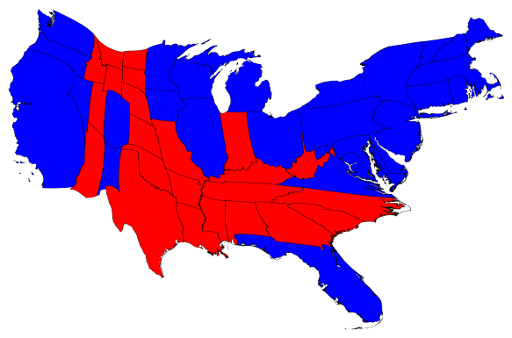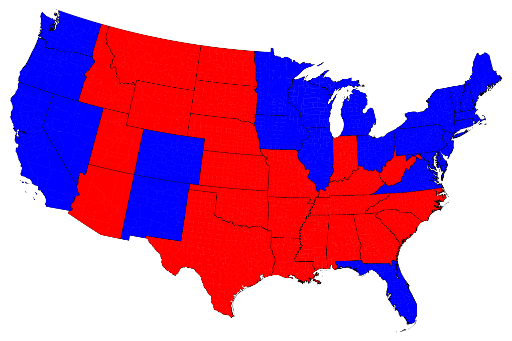This is fascinating...
Most of us are, by now, familiar with the maps the TV channels and web
sites use to show the results of presidential elections. Here is a typical
map of the results of the 2012 election:
The states are colored red or
blue to indicate whether a majority of their voters voted for the
Republican candidate, Mitt Romney, or the Democratic candidate, Barack
Obama, respectively. Looking at this map it gives the impression that the
Republican won the election handily, since there is rather more red on the
map than there is blue. In fact, however, the reverse is true – it
was the Democrats who won the election. The explanation for this apparent
paradox, as pointed out by many people, is that the map fails to take
account of the population distribution. It fails to allow for the fact
that the population of the red states is on average significantly lower
than that of the blue ones. The blue may be small in area, but they
represent a large number of voters, which is what matters in an election.
We can correct for this by making use of a cartogram, a map in which
the sizes of states are rescaled according to their population. That is,
states are drawn with size proportional not to their acreage but to the
number of their inhabitants, states with more people appearing larger than
states with fewer, regardless of their actual area on the ground. On such
a map, for example, the state of Rhode Island, with its 1.1 million
inhabitants, would appear about twice the size of Wyoming, which has half a
million, even though Wyoming has 60 times the acreage of Rhode Island.
Here are the 2012 presidential election results on a population cartogram
of this type:

As you can see, the states have been stretched and squashed, some of them
substantially, to give them the appropriate sizes, though it's done in such
a way as to preserve the general appearance of the map, so far as that's
possible. On this map there is now clearly more blue than red.
The presidential election, however, is not actually decided on the basis of
the number of people who vote for each candidate but on the basis of the electoral
college. Under the US electoral system, each state in the union
contributes a certain number of electors to the electoral college, who vote
according to the majority in their state. (Exceptions are the states of
Maine and Nebraska, which use a different formula that allows them to split
their electoral votes between candidates.) The candidate receiving a
majority of the votes in the electoral college wins the election. The
electors are apportioned among the states roughly according to population,
as measured by the census, but with a small
but deliberate bias in favor of less populous states.
We can represent the effects of the electoral college by scaling the sizes
of states to be proportional to their number of electoral votes, which
gives a map that looks like this:

[Mark Newman, Department
of Physics and Center for the Study of Complex Systems, University of
Michigan]
Read more and see more maps
here...




















